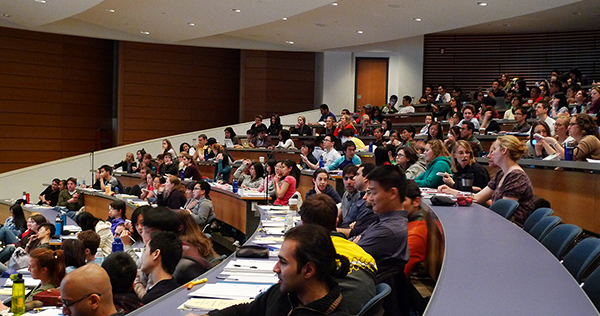Photo courtesy of velkr0.
In this post, I want to focus on the time commitment required to grade student writing. I think it’s worth doing this for two reasons: first, as a counter to the “teachers are lazy” canard, and second, as a reminder of how decisions about teaching loads affects the learning outcomes of students. Cost-cutting measures that increase class size and course loads do have an impact on the students, and this is an issue that often seems to be obscured in policy debates.
Starting from Malcolm Gladwell’s premise in Outliers that it takes 10,000 hours to become expert in any cognitively demanding task (a position he subsequently clarified and reasserted), we should expect that for students to become expert writers in the eight years of high school and their undergraduate degree, they must spend approximately 10,000 hours writing. In those eight years, students spend about 30 weeks per year in school. In order to achieve the requisite 10,000 hours, they must spend four hours writing per week (4×8×30=9,600). My major assumption is that four hours of writing per week produces the equivalent of a ten-page essay. With that assumption, let’s compare the teaching loads of several people I know across the secondary and post-secondary landscapes:
In my (private) high school, the average teaching load was two classes of 15-20 students per teacher per day, plus a club that met usually once a week. In other words, if a teacher assigned a 10-12 page paper every week (far above our workload), that teacher would have at most 400 pages of grading. A lot, right? And if we now imagine a 10-minute meeting with every student to go over comments and next steps, we are looking at a minimum of 30 such meetings, or 5 hours (and no, ten minutes is not enough time to discuss any paper).
The public high school teachers I know teach four classes of 30-40 students per day. Assigning the exact same workload would immediately quadruple the amount of grading: 4×30×10=1200 pages of grading. In other words, you’re looking at War and Peace or the full Les Misérables (but not as well written). Add in our ten minutes of post-essay contact, and we are looking at an additional full day of student meetings. A standard professorial load is, admittedly, lighter at some schools: between two and four classes a term, with widely varying numbers of students (from the very small, 5-10, to the very large, 700). There is sometimes grading support in the form of graduate students. If we imagine a professor without graduate students, we are probably looking at 2-3 classes of 40-50 students each, so on our same hypothetical assignment, 800 pages as a minimum, 2000 on the high end. This division, perhaps unsurprisingly, tends to separate the large and public from the small and elite. Again, if we add in our ten minutes of student contact, the professors (who have more students) get swamped — with a minimum of 80 students, we are looking at more than ten hours of meetings.
And finally there are the “adjuncts”, or “sessionals” (as they are usually called in Canada). This group of instructors has been getting a lot of attention lately, and for good reason. Since they are paid by the class, they often take on grotesque workloads — up to six classes per term — without receiving grading support. In unionized environments, this is often somewhat mitigated, with 4-5 courses and occasional grading help possible. Even so, their classes can be quite large; a very conservative estimate would give the adjunct a minimum of 4 courses of 50 students with no grading help. With our hypothetical assignment, we are looking again at 2000 pages per week and 2000 minutes — over a full day — of contact time. If we take a more extreme example of six classes per term, even with a fairly small 50-student lecture class, this is 3000 pages and 50 hours — more than two days — of contact time. If you don’t think that these course loads are likely or possible, it may help to know that no university in Canada that I know of (although I am willing to be corrected) will assign grading support to class of fewer than 70 students. Canadian instructors, who get paid more than Americans, may be less likely to take on the extreme course load; in the US, where adjunct instructors can be paid less than $2000 per course, teaching a 6-6-6 (including summer term) load may bring in less than $50,000, and is usually spread across multiple colleges and universities.
In the US, a lot of the conversation has focused on the instructors: the difficulty of living this way, their frustration, their anger. While acknowledging this, I want to turn it back to the students for a minute. The students do not choose who teaches their courses; they don’t choose how much to pay those instructors, or how long their contracts are, or how they are treated. But the students are the ones who are affected when they do not get the practice in critical writing, reading, and thinking that their peers at more selective institutions may. No one has the time to grade 3000 pages and have two days of student meetings. Current labor standards in Canada assign 20 minutes to grading a ten-page paper; that is four days of grading, two days of meetings, and one day spent teaching back-to-back for 18 hours in our hypothetical workload. It is not enough time. And that matters. When employers complain that their new employees can’t write, it isn’t because the employees are stupid; it’s because they haven’t practiced. That practice needs to start early, and for it to work, we need more teachers.
About the Author: Jaclyn Neel is a visiting Assistant Professor in Ancient History at York University in Toronto, Ontario.
